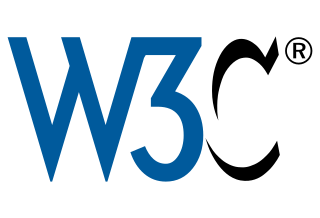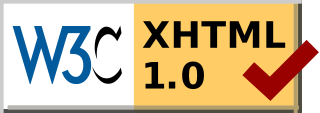
The HyperText Markup Language or HTML is the standard markup language for documents designed to be displayed in a web browser. It can be assisted by technologies such as Cascading Style Sheets (CSS) and scripting languages such as JavaScript.

Markup refers to data included in an electronic document which is distinct from the document's content in that it is typically not included in representations of the document for end users, for example on paper or a computer screen, or in an audio stream. Markup is often used to control the display of the document or to enrich its content to facilitate automated processing. A markup language is a set of rules governing what markup information may be included in a document and how it is combined with the content of the document in a way to facilitate use by humans and computer programs. The idea and terminology evolved from the "marking up" of paper manuscripts, which is traditionally written with a red pen or blue pencil on authors' manuscripts.

Synchronized Multimedia Integration Language ) is a World Wide Web Consortium recommended Extensible Markup Language (XML) markup language to describe multimedia presentations. It defines markup for timing, layout, animations, visual transitions, and media embedding, among other things. SMIL allows presenting media items such as text, images, video, audio, links to other SMIL presentations, and files from multiple web servers. SMIL markup is written in XML, and has similarities to HTML.

The World Wide Web Consortium (W3C) is the main international standards organization for the World Wide Web. Founded in 1994 and currently led by Tim Berners-Lee, the consortium is made up of member organizations that maintain full-time staff working together in the development of standards for the World Wide Web. As of 21 March 2022, W3C had 459 members. W3C also engages in education and outreach, develops software and serves as an open forum for discussion about the Web.
Mathematical Markup Language (MathML) is a mathematical markup language, an application of XML for describing mathematical notations and capturing both its structure and content. It aims at integrating mathematical formulae into World Wide Web pages and other documents. It is part of HTML5 and is a ISO/IEC standard ISO/IEC 40314 since 2015.
An HTML element is a type of HTML document component, one of several types of HTML nodes. HTML document is composed of a tree of simple HTML nodes, such as text nodes, and HTML elements, which add semantics and formatting to parts of document. Each element can have HTML attributes specified. Elements can also have content, including other elements and text.
XForms is an XML format used for collecting inputs from web forms. XForms was designed to be the next generation of HTML / XHTML forms, but is generic enough that it can also be used in a standalone manner or with presentation languages other than XHTML to describe a user interface and a set of common data manipulation tasks.
Web standards are the formal, non-proprietary standards and other technical specifications that define and describe aspects of the World Wide Web. In recent years, the term has been more frequently associated with the trend of endorsing a set of standardized best practices for building web sites, and a philosophy of web design and development that includes those methods.
In web development, "tag soup" is a pejorative for syntactically or structurally incorrect HTML written for a web page. Because web browsers have historically treated structural or syntax errors in HTML leniently, there has been little pressure for web developers to follow published standards, and therefore there is a need for all browser implementations to provide mechanisms to cope with the appearance of "tag soup", accepting and correcting for invalid syntax and structure where possible.

The Markup Validation Service is a validator by the World Wide Web Consortium (W3C) that allows Internet users to check pre-HTML5 HTML and XHTML documents for well-formed markup against a document type definition. Markup validation is an important step towards ensuring the technical quality of web pages. However, it is not a complete measure of web standards conformance. Though W3C validation is important for browser compatibility and site usability, it has not been confirmed what effect it has on search engine optimization.

Tantek Çelik is a Turkish-American computer scientist, currently the Web standards lead at Mozilla Corporation. Çelik was previously the chief technologist at Technorati. He worked on microformats and is one of the principal editors of several Cascading Style Sheets (CSS) specifications. He is author of HTML5 Now: A Step-by-Step Video Tutorial for Getting Started Today (ISBN 978-0-321-71991-1).
In computing, quirks mode is a technique used by some web browsers for the sake of maintaining backward compatibility with web pages designed for old web browsers instead of strictly complying with W3C and IETF standards in standards mode.
RDFa or Resource Description Framework in Attributes is a W3C Recommendation that adds a set of attribute-level extensions to HTML, XHTML and various XML-based document types for embedding rich metadata within Web documents. The Resource Description Framework (RDF) data-model mapping enables its use for embedding RDF subject-predicate-object expressions within XHTML documents. It also enables the extraction of RDF model triples by compliant user agents.
In computer science and web development, XML Events is a W3C standard for handling events that occur in an XML document. These events are typically caused by users interacting with the web page using a device, such as a web browser on a personal computer or mobile phone.

HTML5 is a markup language used for structuring and presenting content on the World Wide Web. It is the fifth and final major HTML version that is a World Wide Web Consortium (W3C) recommendation. The current specification is known as the HTML Living Standard. It is maintained by the Web Hypertext Application Technology Working Group (WHATWG), a consortium of the major browser vendors.
Extensible HyperText Markup Language (XHTML) is part of the family of XML markup languages. It mirrors or extends versions of the widely used HyperText Markup Language (HTML), the language in which Web pages are formulated.

EPUB is an e-book file format that uses the ".epub" file extension. The term is short for electronic publication and is sometimes styled ePub. EPUB is supported by many e-readers, and compatible software is available for most smartphones, tablets, and computers. EPUB is a technical standard published by the International Digital Publishing Forum (IDPF). It became an official standard of the IDPF in September 2007, superseding the older Open eBook (OEB) standard.

Cascading Style Sheets (CSS) is a style sheet language used for describing the presentation of a document written in a markup language such as HTML or XML. CSS is a cornerstone technology of the World Wide Web, alongside HTML and JavaScript.
XFrames is an XML format for combining and organizing web based documents together on a single webpage through the use of frames. Similarly to HTML Frames, XFrames can be made useful through its power to create a content frame that is scrollable while other frames - such as sidebar menus, the header and footer remain in place on the page. XFrames will be particularly useful to web developers who will be able to modify a single document and have that modification appear on all pages that contain the document within a frame.
XHTML+RDFa is an extended version of the XHTML markup language for supporting RDF through a collection of attributes and processing rules in the form of well-formed XML documents. XHTML+RDFa is one of the techniques used to develop Semantic Web content by embedding rich semantic markup. Version 1.1 of the language is a superset of XHTML 1.1, integrating the attributes according to RDFa Core 1.1. In other words, it is an RDFa support through XHTML Modularization.







